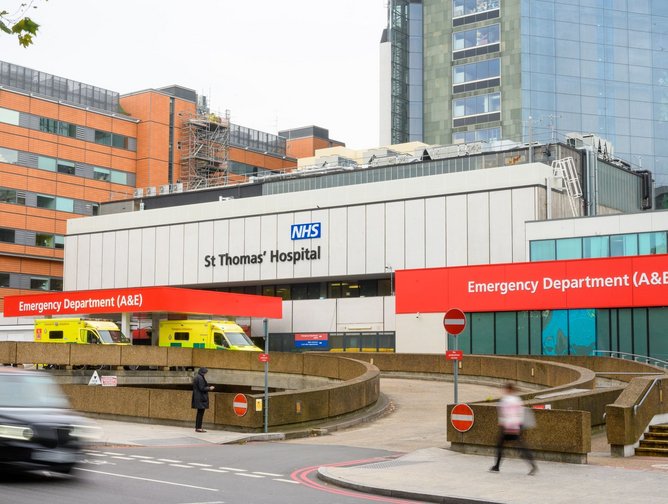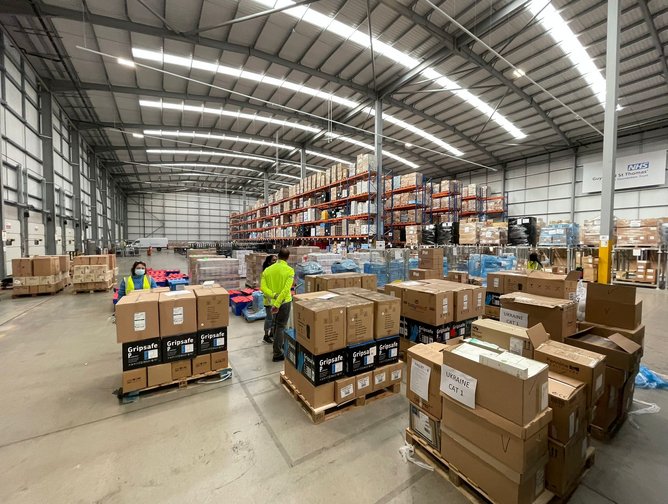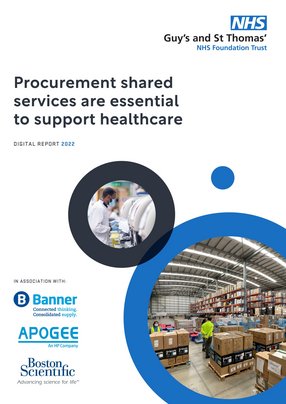Procurement shared services’ role in supporting healthcare
The coronavirus pandemic took a struggling National Health Service (NHS) and imposed even further pressures on the organisation that was already stretched to its limits. One important lesson that COVID-19 taught us is that supply chain resilience is critical to maintaining services. The procurement shared service team played a key role to ensure the Trust maintained supply and supported other hospitals across the region, from setting up a 3D Print Farm and air freighting PPE from China to providing over one million items as mutual aid to over 40 healthcare organisations.
The organisation’s procurement team, comprised of around 200 employees, is responsible for sourcing, systems, and supply chain operations across four NHS Trusts with responsibility for over £500mn direct spend.
With just over 20 years at the organisation, David Lawson, Chief Procurement Officer at the Trust divulged the developments in the organisation’s procurement strategy throughout the pandemic and his team’s contribution to procurement programmes and initiatives.
Leading procurement strategy to streamline healthcare
Over the past few years, Guy’s and St Thomas’ has worked to transform procurement and supply chain from deployment, the largest implementation of automated inventory management systems in Europe to leading major complex commercial initiatives. Procurement and supply chain is critical to the day-to-day running of healthcare services. In 2021 for example, the team led the re-procurement of Pathology Services across South East London, covering a patient population of two million, processing over 35 million tests per year, and with an annual spend of £135mn. The new 15-year contract worth £2bn involved a major service transformation with the consolidation of 70% of test activity from four hospital sites into a new pathology hub together with the adoption of new digital systems.
Lawson commented that “it would be difficult to imagine a more complex procurement.”
He explains: “You had an incumbent joint venture supplier that the two Trusts — Guy’s and St Thomas’ and King’s College Hospita l— part-owned under a joint venture structure, you had a major service transformation in terms of service consolidation, and you had a mission-critical service which touched almost every patient that interfaced with the local health system from GP Surgery to Acute Hospitals.”
Understanding the criticality of the process and the involvement of procurement, Lawson set about leading his team to streamline proceedings, which, through competitive dialogue between bidders, led to a change in supplier and a novel “buy-out buy-in approach into the Joint Venture to avoid the need to TUPE transfer over 1,500 staff and ensure a smooth service transition.
Lawson highlights the three main challenges of the process, which were stakeholder engagement to achieve agreement on the new operating model, ensuring robust bids despite gaps in key data sets, and despite the complexity and scale of the procurement, keeping the evaluation simple and manageable.
The procurement team also recently led the £10bn Increasing Capacity Framework Agreement on behalf of NHS England to support reducing the current backlog of elective activity by making available independent sector capacity to the NHS. The new framework agreement replaced a capacity model in which block contracts were agreed upon with the main independent sector providers irrespective of whether the capacity was used or not. The framework was set up in under 12 weeks with over 100 providers listed.
“While the rest of the NHS was tied up with treating COVID patients, the challenge for the NHS was to try and get to a point of business as usual, in order to avoid or mitigate a growing backlog of elective cases. To secure funding from the treasury, there was a need to move away from direct awards and the previous capacity model to demonstrate value for money,” Lawson says.
“So, I was asked to support NHS England setup. A new national framework where independent sector providers bid against all procedures that are available on the national tariff,” Lawson says. “My role was to set up the procurement strategy and work out a timetable to deliver the framework within quite a short period of time — within about 12 weeks — and make that ready for the new calendar year in January when the existing block contracts were due to expire.”
SmartTogether transforms the NHS with access to procurement and supply chain expertise
When it comes to procurement in the NHS, the siloed nature of its operations has presented weaknesses over the years due to the lack of scale and investment. Five years ago, the SmartTogether shared service was established to scale up both procurement and supply chain capacity and capability. “It was very much formed on the back of the hospitals, around us asking for help and support to transform the procurement service,” Lawson says. “In response to the request for help, we expanded the team and created SmartTogether.”
SmartTogether was able to apply common performance standards for order management, inventory management, and CIP delivery. In the first year of Lewisham and Great Ormond Street joining the shared service, CIP delivery increased five-fold. Lawson explains how this helps improve procurement: “We have a scorecard with key metrics and we compare each of the member trusts against national benchmarks, as well as benchmarks within the shared service to drive that performance.” He also spoke about some of the resulting effects of SmartTogether: “We're seeing process improvement, expansion of inventory management systems, and cost improvement delivery as well. So we've been able to influence more spend.”
Channelling NHS contracts through select strategic partners
Without its partner organisations, the SmartTogether service would not have been as well-received as the team has experienced. The organisation works closely with selected strategic partnerships to encourage efficiency and more sustainable operations across its network of healthcare services.
SmartTogether partners with Apogee, an HP company specialising in print services, to funnel its printing resources and technology solutions through the company, which supports all the member Trusts of the shared service. Partnering with Apogee resulted in an organisation-wide revamp of its printers, creating an ecosystem of manageable and more sustainable machines, and also allowed SmartTogether to leverage Apogee’s managed print services at scale.
Lawson explains how the Trust has negotiated better solutions across all operations. “It means that we've been able to negotiate better technology and better processes as well,” he says.
“So, from a sustainability perspective, benefits around energy efficiency, and from a cost perspective, double-digit percentage savings in terms of having a larger single contract, a multi-year contract and developing a partnership with Apogee going forward.”
Following this, Lawson delves into another strategic partnership as he talks about some of the challenges that the Trust faces in terms of risk management, particularly in its supply chain, which is a critical phase in ensuring fast and reliable patient care.
CEVA Logistics works with Guy’s and St Thomas’ to manage its offsite Supply Chain Hub; a necessary response to the coronavirus pandemic that supported deliveries to the hospital and supported the wider London Region. To help gauge the scale of the task, Lawson says: “We previously had over 40,000 trucks arriving into the two Trust campus sites, which equated to a truck delivery hitting one of our loading bay every three minutes.”
While the offsite Supply Chain Hub, based in Dartford, was primarily a response to COVID-19, the organisation has now set up an in-house wholesaler within the facility; a process that was implemented based on new insights from the pandemic. “For just over 1,000 high-risk product lines, we hold about a month’s worth of inventory to enable a same-day delivery service to over 50 Main Theatres,” says Lawson.
The logistics firm is also working to support the Trusts sustainability strategy with the adoption of bio-fuel and electric vehicles for bulk consolidated deliveries, together with a pilot of a river cargo service for rapid parcel deliveries from the Supply Chain Hub at Dartford into Guy’s Hospital via Butler’s Wharf.
The Supply Chain Hub is also been used to support current work to provide urgent medical supplies into Ukraine. Working in partnership with the Ukrainian Medical Association the hub has acted as a staging point to ship deliveries into Lviv and Kyiv hospitals.
Sustainable sourcing of products and procuring high-end medical devices
One of the themes that could be picked out from the SmartTogether service is the commitment to core values and how this plays a critical role in sourcing goods and, ultimately, finding suppliers with similar core values.
For such large-scale operations, the Trust has begun to select products more carefully. A prime example of this can be seen through its partnership with Banner, an expert provider of workplace supplies, as the organisation focuses a lot of its attention on its environmental, social, and governance (ESG) impacts.
Lawson further explains the importance of social value when it comes to engaging with suppliers: “When we carried out the tender process, we weighted social value at 20%. So we weighted it quite high and set up some specific requirements from a sustainability perspective.”
He continues: “We pulled together the different sustainability managers from each trust to set out the standards from an environmental perspective in terms of product, but also in terms of delivery model.”
Ultimately, this process is governed by its partner organisation’s ability to provide transparency, which is something the Trust is also aiming for with Boston Scientific, a leading global provider of medical devices.
“We buy a wide range of their devices across a number of clinical settings,” says Lawson.
“Boston is an example of a medical device company that we're trying to establish a strategic partnership with and that's looking at different elements or different initiatives.
This really sums up the core activities of Guy’s and St Thomas’ that we can expect to see over the next few years. As a provider of local healthcare services with specialist capabilities required by the nation, the Trust will continue to develop the way it operates to improve patient care.
The coronavirus pandemic has highlighted some of the key areas in which the organisation must innovate to meet the demands of an ever-growing population, strengthening its strategic partnerships and streamlining procurement and supply chain activities to ensure that patients receive what they need when they need it.
“Post-COVID, we’re now trying to learn from the experience of COVID-19 and understand the benefits in the sense of being able to make changes for the good and to use that as the catalyst for more change.”




- Wellplaece well-placed to dominate dental procurement marketDigital Procurement
- Boots: Drones - the future of UK medical prescription supplyTechnology & AI
- Arkestro: the future of healthcare procurement is predictiveDigital Procurement
- Healthtrust Europe: sustainable procurement & social valueSustainable Sourcing

